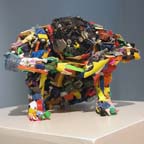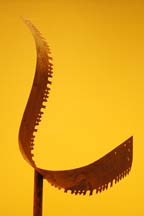|


COVER
STORY | IN
THE NEWS | PUBLISHER | GARDEN | GOOD NEWS | CALENDAR
Notes
from a traveler
by DAVID GLEESON
I HAVE BEEN VISITING HUMBOLDT
COUNTY regularly since 1990, and, besides my friends and the
spectacularly beautiful countryside, one of the great pleasures
of being here is the lively, vibrant artistic community. So I
was particularly dismayed to read about the 86 percent cut to
the California Arts Council budget last August. The long-term
impact was seen recently with the announcement that the Eureka-based
Ink People faced closure due to a funding shortfall of $2,500.
Considering the range of projects they deliver, that comparatively
small sum seems a bargain and it's shameful that they have to
beg.
One of their most visible projects
-- certainly for me and so, I suppose, for other visitors here
-- is the Rural Burl Mural Bureau. Their public murals in Eureka
are a great advertisement not only for a thriving artistic community,
but also for a locality that prizes creativity and has a sense
of humor. I have come to love Duane Flatmo's cartoon alley cats
(G Street, between Fourth and Fifth), his seedy dogs (E Street,
again between Fourth and Fifth) and the surreal urban streetscape
he created by the Post Office on H Street. His current show at
Gallery Dog (214 E St.) is typical of the art scene here: There's
so much good art around that it often has to hang on the walls
of shops for want of gallery space. Flatmo may be a celebrated
muralist, but he's not too proud to compete with scented candles
and fancy soaps.
[Pictured above,
"High Impact" by Sarah Jackson; right, "Untitled"
by Anthony Johnson]
Eureka and Arcata have gift
shops galore -- for a helpless holiday shopper like myself, both
towns are shopping heaven. Last year I discovered a shop in Eureka
that has officially become my own personal favorite, beating
off strong competition from exotic emporia where I live in London,
and other great shops that have captured my heart in New York,
San Francisco and Berlin. OBJX (Second and G streets) represents
the last word in tastefully idiosyncratic merchandising, where
the space and its disparate contents achieve an overall cohesiveness
that turns the place into one big installation that yields as
much pleasure in browsing as a library, department store and
art museum. All this from one shop! The selection of goods on
sale ranges from carefully chosen art books and cards (the Humboldt
gift shop staples) to a selection of carnivorous plants, garden
gnomes, antique crucifixes, stuffed animals, old dolls and mannequins,
faded advertisements and one-offs like the old U.S. mailbox standing
guard near the counter. That such a varied selection can all
be made to appear like objects of desire is a feat in itself;
that the whole shop resembles an installation that has been carefully
curated by a discerning eye to produce a pseudo-Victorian sepulchral
environment is nothing short of spectacular. From wonderful antiques
to salvaged junk, this is not so much a shop as a realization
of a creative vision so confident that I find it hard to believe
the owner is not besieged with offers from fashionable urban
multinationals.
Talking of creative junk, the
current show at the Morris Graves Museum is worth seeing. Billed
as "the Ninth Annual Junque Arte Competition and Exhibition,"
I confess I approached it with misgivings, expecting a parade
of recycled "joke" artworks. My snotty misgivings were
happily subverted by some surprisingly powerful works of art.
Deborah Kallish's "Racket" is a simple study of a sleeping
figure sketched over a newspaper story about domestic noise,
which imposes a dignified calm on its salvaged materials, whilst
Sarah Jackson's "High Impact" is a hunched figure fashioned
from broken toys that speaks with a horrifying eloquence about
the lasting damage of shattered innocence. Nancy Tobin's "Untitled"
is a sculpture fashioned from a shop display dummy "Playtex
Living Bra" and over 20 dolls' heads arranged like a floral
lei, each connected to the "bra" by a plastic tube
from its mouth. Fascinating and repulsive, this piece resonates
with the tension between male desire and biological obligation
as the perfectly formed, unsagging breasts suckle a herd of hungry
children. My personal favorite is a sculpture created from three
pieces of salvaged rusty metal where two parts are used to make
a plinth for the third, which is a twisted section of a large
manual saw. Transformed from rusty junk to gracefully mounted
artwork, the elegant simplicity of this discarded piece of a
saw respects the found object by leaving it essentially unchanged
and allowing it to redefine itself as an essay in fluid abstraction.
Well done, Anthony Johnson, for "Untitled."
These are my personal favorites
in a show that, although it awarded prizes for works that were
essentially sculptural one-liners (for example, Ryan Heppler's
cardboard rocking chair and Shelby Walker's goldfish made from
old lifejackets), once again proved the ingenuity and creative
depth in this artistic community.
The Morris Graves Museum speaks
volumes about this same community. An excellent building, whose
salaried staff of just 4.25 persons and an army of willing volunteers
manages to mount a year-round exhibition program. But take a
look at the sheer size of the artistic community here, and this
municipal gallery suddenly appears very small, with little hope
of expansion in the current economic climate. It amounts to a
small facility for such a huge community.
It's surely time that the tired
old paradigm of budget cuts always hitting "luxuries"
like arts organizations was rethought here. Given that Humboldt
is such an inspiring creative center, shouldn't someone consider
actively investing in the arts? Look at such successful examples
as the Bilbao Guggenheim and London's Tate Modern: Both were
huge initial expenses, but have more than repaid their investment
with tourist revenue and a raised profile for the creative industries
in each country. Nearer to home, San Francisco's MOMA set new
precedents for successful fund-raising as virtually every brick
was donated from business sponsors. Humboldt's artistic community
is not merely a luxury but a vast potential resource that defines
the character of North Coast California.
EDITOR'S NOTE: Last week,
Art Beat columnist Linda Mitchell asked if she might skip a column
since she is busy editing The Palette,
the Humboldt Arts Council's annual publication. With amazing
serendipity, an e-mail query came from David Gleeson, a British
art critic who was passing through Humboldt County. Gleeson has
written for magazines in London, Madrid, St. Petersburg and for
Art in America and Art Papers here in the United
States. He also serves as press officer for the Whitechapel Gallery
in London.
Linda Mitchell can be reached
via
COVER
STORY | IN THE NEWS | PUBLISHER | GARDEN | GOOD NEWS | CALENDAR
Comments?

© Copyright 2003, North Coast Journal,
Inc.
|